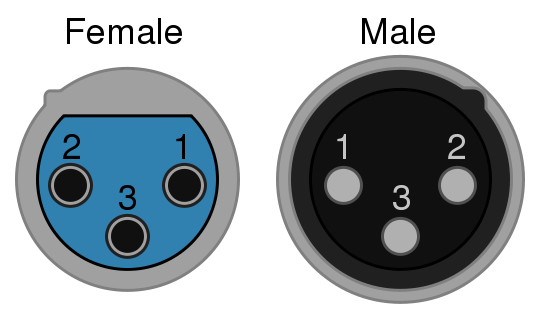Frequently Asked Questions
Standard M-101:
| Microphone Principle | Dynamic |
| Microphone Impedance | 150 Ω nominal |
| Microphone Sensitivity | 160uV nom. into 150-ohm load re: 94dB SPL ¼†1kHz |
| Microphone Frequency Response | 100Hz – 4kHz |
| Microphone DC Supply V | N/A |
| Source Resistance | 150 Ω nominal |
M2 Pro Audio:
| Microphone Principle | Dynamic |
| Microphone Impedance | 150 Ω nominal |
| Microphone Sensitivity | 320uV nom. into 150-ohm load re: 94dB SPL ¼†1kHz |
| Microphone Frequency Response | 100Hz – 10kHz |
| Microphone DC Supply V | N/A |
| Source Resistance | 150 Ω nominal |

5 pin XLR connectors are becoming increasingly
common in Pro Audio wireless belt packs as they afford the ability to have a
stereo headset. These typically have 3 pins for the stereo headphone signal -
left, right, and ground, and 2 pins for the unbalanced microphone signal.
Models vary and it is best to consult the manufacturers documentation such as
operation manuals.
The wires on the 8500 Series and 8600 Series
headsets are color coded, red(hi) and white for the mic, black and green(hi)
for the earphones. For a typical 5 pin camera pin out for mono, wire them
to the 5 pinXLR as follows: Red- pin 2, White- pin 3, Green- pin
4, Black- pin 3, Shield-shield
Stereo models H8530 and DC 8632 include
additional conductors for the second earphone signal. The H8530 adds yellow and blue for the left
earphone. The DC 8632 adds Yellow for left earphone. So you'd wire them this
way to the camera 5 pin XLR connector: Red- pin
2, Yellow- pin 4, Green- pin 5, Blue, White & Black- pin
3, Shield-shield.
H = Headset
C = Cord, Adapter, PTT adapter or Extension Cord
M = Module
U = Utility intercom module
Model numbers are set up in series. The first two digits indicate the series i.e. H3341 is a headset in the 3300 series, C38-12 is a 3800 series cable.
The second two digits tell about the configuration of the headset. The pattern is as follows:
Hxx10 & Hxx20 = Mic shield microphone
Hxx30 = Boom microphone, over the head style
Hxx40 = Boom microphone, behind the head style
Hxx50 & Hxx60 = Listen only, no microphone
Hxx70 & Hxx80 = Cap attachable or lightweight model
Hxx90 = Single ear over the head style
You'll note that the fourth number sometimes changes. That just means the product is a variant on the series. In other words there could be two headsets that are very similar and vary on some feature and so have the same basic number but one digit different i.e. H3340 and H3341. The difference is that the H3340 has two speakers and the H3341 has only one.
Additionally, some products only have part numbers and you will need to check the compatibility table or with your two way dealer to see what series the part you have belongs to.
BTH = Behind the head style headset
ULW = Ultra Light Weight, Single Ear, Over the head style

